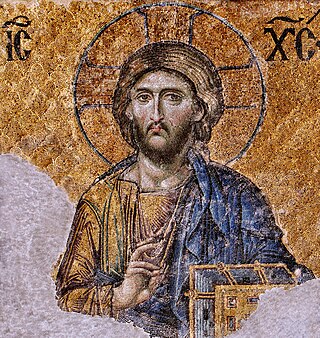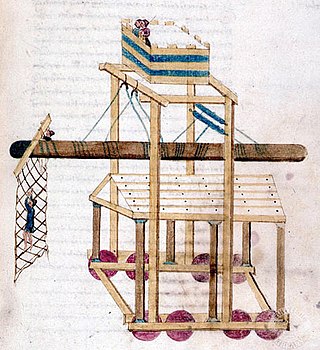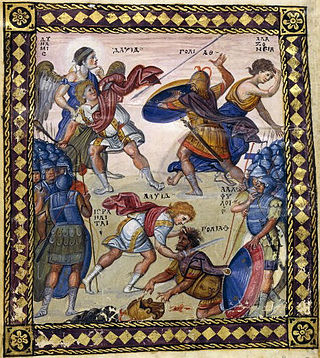
Byzantine art comprises the body of artistic products of the Eastern Roman Empire, as well as the nations and states that inherited culturally from the empire. Though the empire itself emerged from the decline of western Rome and lasted until the Fall of Constantinople in 1453, the start date of the Byzantine period is rather clearer in art history than in political history, if still imprecise. Many Eastern Orthodox states in Eastern Europe, as well as to some degree the Islamic states of the eastern Mediterranean, preserved many aspects of the empire's culture and art for centuries afterward.
Michael Panaretos was an official of the Trapezuntine empire and a Greek historian. His sole surviving work is a chronicle of the Trapezuntine empire of Alexios I Komnenos and his successors. This chronicle not only provides a chronological framework for this medieval empire, it also contains much valuable material on the early history of the Ottoman Turks from a Byzantine perspective, however it was almost unknown until Jakob Philipp Fallmerayer discovered it in the nineteenth century among the manuscripts of the Biblioteca Marciana of Venice. "Owing to this drab but truthful chronicle," writes the Russian Byzantist Alexander Alexandrovich Vasiliev, "it has become possible to a certain extent to restore the chronological sequence of the most important events in the history of Trebizond. This Chronicle covers the period from 1204 to 1426 and gives several names of emperors formerly unknown."

Hero of Byzantium is a name used to refer to the anonymous Byzantine author of two treatises, commonly known as Parangelmata Poliorcetica and Geodesia, composed in the mid-10th century and found in an 11th-century manuscript in the Vatican Library. The first is a poliorketikon, an illustrated manual of siegecraft; the second is a work in practical geometry and ballistics, which makes use of locations around Constantinople to illustrate its points. The manuscript consists of 58 folios and 38 colored illustrations.

Isaac Komnenos or Comnenus was the third son of Byzantine Emperor Alexios I Komnenos and Empress Irene Doukaina. He was raised to the high rank of sebastokrator by his older brother John II Komnenos in reward for his support, but they later fell out, as Isaac began to covet the throne.

Byzantine medicine encompasses the common medical practices of the Byzantine Empire from c. 400 AD to 1453 AD. Byzantine medicine was notable for building upon the knowledge base developed by its Greco-Roman predecessors. In preserving medical practices from antiquity, Byzantine medicine influenced Islamic medicine and fostered the Western rebirth of medicine during the Renaissance.
Cyril Alexander Mango was a British scholar of the history, art, and architecture of the Byzantine Empire. He is celebrated as one of the leading Byzantinists of the 20th century.

The Paris Psalter is a Byzantine illuminated manuscript, 38 x 26.5 cm in size, containing 449 folios and 14 full-page miniatures. The Paris Psalter is considered a key monument of the so-called Macedonian Renaissance, a 10th-century renewal of interest in classical art closely identified with the emperor Constantine VII Porphyrogenitus (909-959) and his immediate successors.

The Joshua Roll is a Byzantine illuminated manuscript of highly unusual format, probably of the 10th century Macedonian Renaissance, believed to have been created by artists of the imperial workshops in Constantinople, and now in the Vatican Library.

Byzantine studies is an interdisciplinary branch of the humanities that addresses the history, culture, demography, dress, religion/theology, art, literature/epigraphy, music, science, economy, coinage and politics of the Eastern Roman Empire. The discipline's founder in Germany is considered to be the philologist Hieronymus Wolf (1516–1580), a Renaissance Humanist. He gave the name "Byzantine" to the Eastern Roman Empire that continued after the Western Roman Empire collapsed in 476 AD. About 100 years after the final conquest of Constantinople by the Ottomans, Wolf began to collect, edit, and translate the writings of Byzantine philosophers. Other 16th-century humanists introduced Byzantine studies to Holland and Italy. The subject may also be called Byzantinology or Byzantology, although these terms are usually found in English translations of original non-English sources. A scholar of Byzantine studies is called a Byzantinist.
Saint Athanasia of Aegina was a saint who worked in the Byzantine Empire and was for a while adviser to the Empress Theodora II.

The Menologion, Menologium, or Menology of Basil II is an illuminated manuscript designed as a church calendar or Eastern Orthodox Church service book (menologion) that was compiled c. 1000 AD for the Byzantine Emperor Basil II. It contains a synaxarion, a short collection of saints' lives, compiled at Constantinople for liturgical use and around 430 miniature paintings by eight different artists. It was unusual for a menologion from that era to be so richly painted. It currently resides in the Vatican Library . A full facsimile was produced in 1907.
John Geometres or Kyriotes, was a Byzantine poet, soldier, and monk. He is one of the main literary figures of the Macedonian Renaissance.

Doula Mouriki was a Greek Byzantinologist and art historian. She made important contributions to the study of Byzantine art in Greece.

The Sacra Parallela is a Byzantine florilegium of quotes in Greek from the Bible and patristic texts used in the instruction of ethics, morals and asceticism.

The Paris Gregory is an illuminated manuscript of the Homilies of Gregory of Nazianzus commissioned in Constantinople by Patriarch Photios I as a commemoration to the Emperor Basil I between 879 and 883. The illustrations from the manuscript are held today in the Bibliothèque nationale de France in Paris as part of their collection of Greek manuscripts.
Leslie Brubaker is an expert in Byzantine illustrated manuscripts. She was appointed Professor of Byzantine Art at the University of Birmingham in 2005, and is now Professor Emerita. Her research interests includes female patronage, icons and the cult of the Virgin Mary. She was formerly the head of Postgraduate Studies in the College of Arts and Law, University of Birmingham. Professor Brubaker is the Chair of the Society for the Promotion of Byzantine Studies. Her work is widely stocked in libraries around the world.

Byzantine illuminated manuscripts were produced across the Byzantine Empire, some in monasteries but others in imperial or commercial workshops. Religious images or icons were made in Byzantine art in many different media: mosaics, paintings, small statues and illuminated manuscripts. Monasteries produced many of the illuminated manuscripts devoted to religious works using the illustrations to highlight specific parts of text, a saints' martyrdom for example, while others were used for devotional purposes similar to icons. These religious manuscripts were most commissioned by patrons and were used for private worship but also gifted to churches to be used in services.

Codex Mutinensis graecus 122 is a 15th-century codex written in Greek, today stored in the Biblioteca Estense in Modena, Italy. The designation Mutinensis gr. 122 is modern and the codex itself bears the title Epitome of Histories as the bulk of its content is made up of a copy of large parts of the 12th-century Byzantine historian Joannes Zonaras's Epitome of Histories.
The Topkapı or Seraglio Octateuch is a 12th-century Byzantine illuminated manuscript of the Octateuch. It is named after its location in the library of the Topkapı Palace in Istanbul, the former residence ("seraglio") of the Ottoman sultans. It was sponsored by the Byzantine prince Isaac Komnenos, and remained unfinished due to the latter's death.












